
Holy Week: A biblical chronology and liturgical guide
“St. Athanasius calls Easter ‘the Great Sunday’ and the Eastern Churches call Holy Week ‘the Great Week.’ The mystery of the Resurrection, in which Christ […]

“St. Athanasius calls Easter ‘the Great Sunday’ and the Eastern Churches call Holy Week ‘the Great Week.’ The mystery of the Resurrection, in which Christ […]

 The Catholic faithful gathered in the Cenacle in Jerusalem for the Mass of the Lord’s Supper that the Franciscan friars celebrated on Holy Thursday, March 28, 2024. The Cenacle is at the center of strong tensions and disputes regarding ownership and rights of access and celebration. An ancient tradition places King David’s tomb here and over the centuries Jews and Muslims have leveraged this to first expel the Franciscans and then to prevent Christian worship, which they deemed sacrilegious. / Credit: Marinella Bandini
The Catholic faithful gathered in the Cenacle in Jerusalem for the Mass of the Lord’s Supper that the Franciscan friars celebrated on Holy Thursday, March 28, 2024. The Cenacle is at the center of strong tensions and disputes regarding ownership and rights of access and celebration. An ancient tradition places King David’s tomb here and over the centuries Jews and Muslims have leveraged this to first expel the Franciscans and then to prevent Christian worship, which they deemed sacrilegious. / Credit: Marinella Bandini
Jerusalem, Mar 28, 2024 / 17:15 pm (CNA).
On Holy Thursday, the doors of the Cenacle in Jerusalem were opened to welcome the Franciscans of the Custody of the Holy Land. In this “Upper Room,” called the Cenacle in the Holy Land, Jesus had his Last Supper, washed his apostles’ feet, and instituted the Eucharist.
It was here that the Franciscans celebrated the Mass of the Lord’s Supper, reenacting those same gestures. (At the Basilica of the Holy Sepulcher, however, the celebration is held on Thursday morning due to the Status Quo. Here is Cardinal Pierbattista Pizzaballa’s homily from that Mass.)
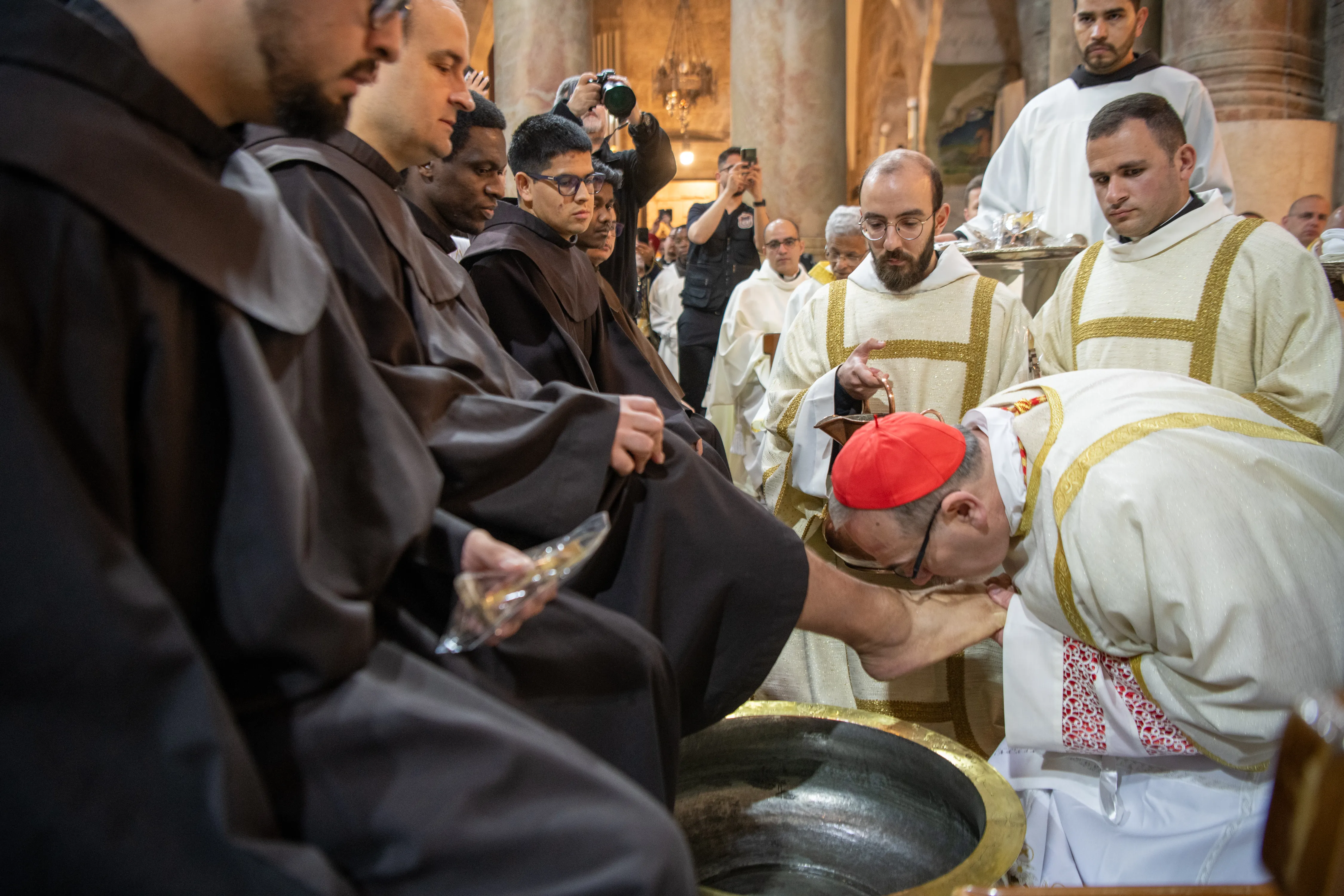
The custos of the Holy Land, Father Francesco Patton, presided over the Eucharistic celebration at the Cenacle. In his homily, before washing the feet of six teachers and six students from the Terra Sancta School in Jerusalem, he emphasized the value of the “new commandment” that Jesus gave to his apostles here: “As I have loved you, so you also should love one another” (Jn 13:34).
“To love means to give oneself and to serve,” he said. “In this celebration, we want to nourish ourselves with Jesus because if he is alive within us, then we too will become capable of loving one another as he loved us. And we also want to learn from Jesus not to be served but to serve.”
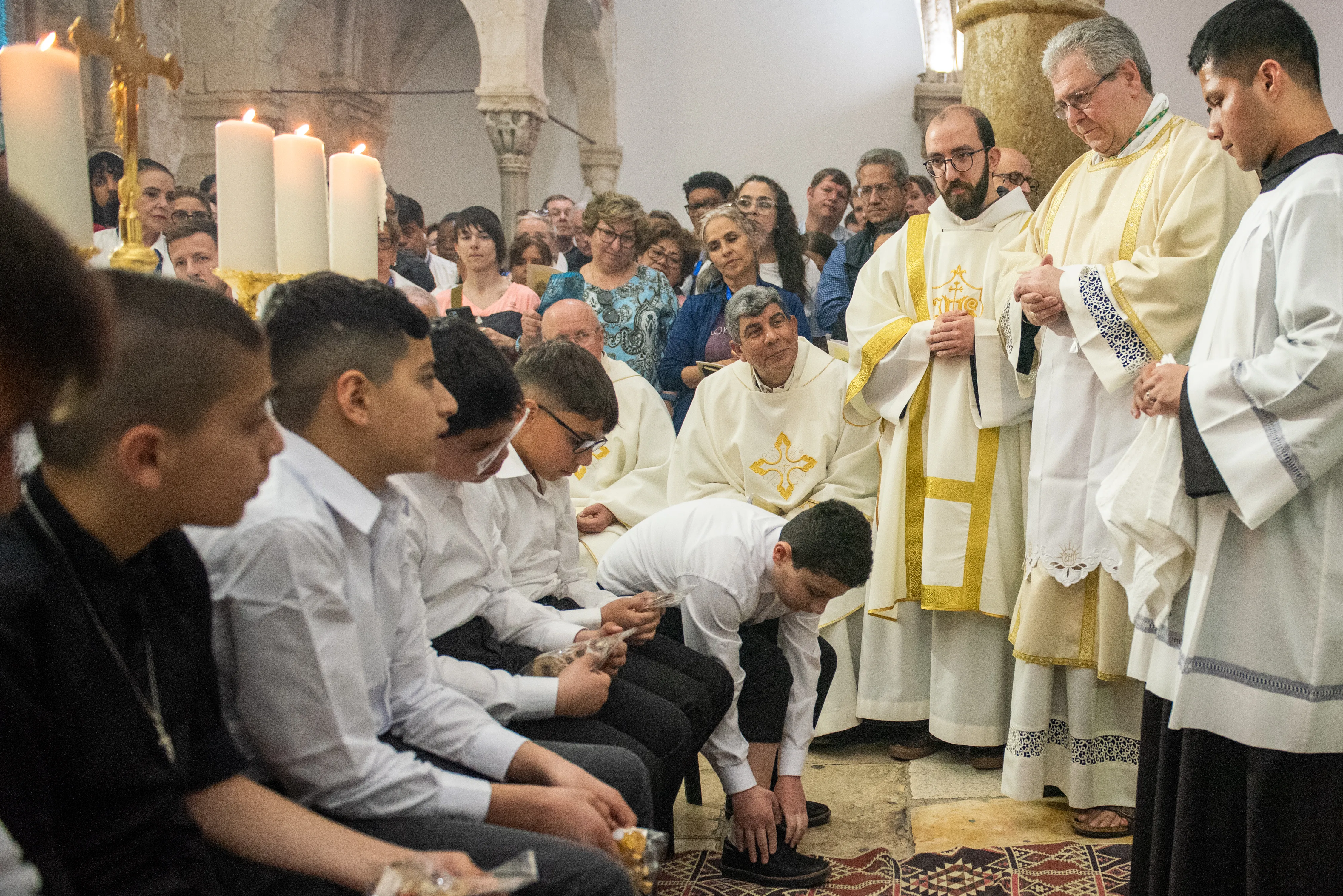
Holy Thursday is the only day, along with Pentecost Sunday, when the Franciscans have the right to gather in the Upper Room to pray. Usually, it is a liturgy of the word, but since 2021 they have celebrated Mass. Outside, Israeli Army personnel ensure security.
The Cenacle is at the center of strong tensions and disputes regarding ownership and rights of access and celebration. An ancient tradition places King David’s tomb here, and over the centuries, Jews and Muslims have leveraged this place to first expel the Franciscans and then to prevent Christian worship, which they deem sacrilegious.
Father Narciso Klimas, historian and archivist of the Custody of the Holy Land, explained to CNA: “The Custody has all the documents confirming our ownership of Mount Zion.” Even today, traces of Christian presence are visible, both in the architecture of the place and in some symbols.
“The presence of the Franciscans at the Cenacle,” Klimas explained, “dates back to 1342, but as early as 1333, the rulers of Naples, Robert of Anjou and Sancha of Majorca, acquired the land and donated it to the friars. This was the first headquarters of the Custody of the Holy Land.” To this day, the official title of the Custos of the Holy Land is “Guardian of Mount Zion and the Holy Sepulchre.”

In 1421, a rabbi submitted a petition to the local emirs, claiming the right for Muslims and Jews to this place due to the presence of King David’s tomb. One hundred years later, Klimas continued, “the Ottomans used this argument to gradually expel the Franciscans, until in 1551 the sultan decreed the total expulsion of the Franciscans from Mount Zion.” The Cenacle first became a mosque and later, in the lower part, also a synagogue.
“Since then,” Klimas recounted, “the Franciscans have never stopped attempting to regain possession of the Cenacle. The friars have always tried to ensure a presence, at least on Holy Thursday and Pentecost, sometimes even with methods that are not exactly orthodox (such as bribing the local guardian).”
Something began to change in the 19th century, during the time of the Ottoman Sultan Abdülmecid. Since then, the Franciscans have had the right to pray at the Cenacle on Holy Thursday and Pentecost. After a failed attempt in the 1930s to regain control of it, the friars managed to purchase adjacent land where they built the convent of San Francesco “ad Coenaculum” (next to the Cenacle).
In 1948, with the founding of the State of Israel, the entire Mount Zion came under Israeli control, and until today, the Israeli state owns the entire complex of the Cenacle. The neighborhood has a strong Jewish religious character and is characterized by the presence of synagogues and rabbinical schools.

“Even if the Cenacle cannot return to our hands,” Klimas explained, “we ask at least to celebrate regularly, even with pilgrims, without the need for special permits.”
Negotiations on these matters (taxation and property) have been ongoing for over 25 years between the Holy See and the State of Israel, following the signing of the Fundamental Agreement in 1993 and the agreement recognizing the legal personality of the Catholic Church in Israel in 1997.
Despite the slow pace of diplomatic negotiations, some practical progress can be observed informally. The ability to celebrate Mass on Holy Thursday at the Cenacle is among these developments. Permissions to access the site on other special occasions are usually granted without significant issues as well.
After the Mass at the Cenacle, as tradition dictates, the Franciscans proceeded in a procession to three churches in two other symbolic places: the Armenian churches of St. James and of the Holy Archangels (of the Armenian Apostolic Church), and the Syro-Orthodox Church of St. Mark.
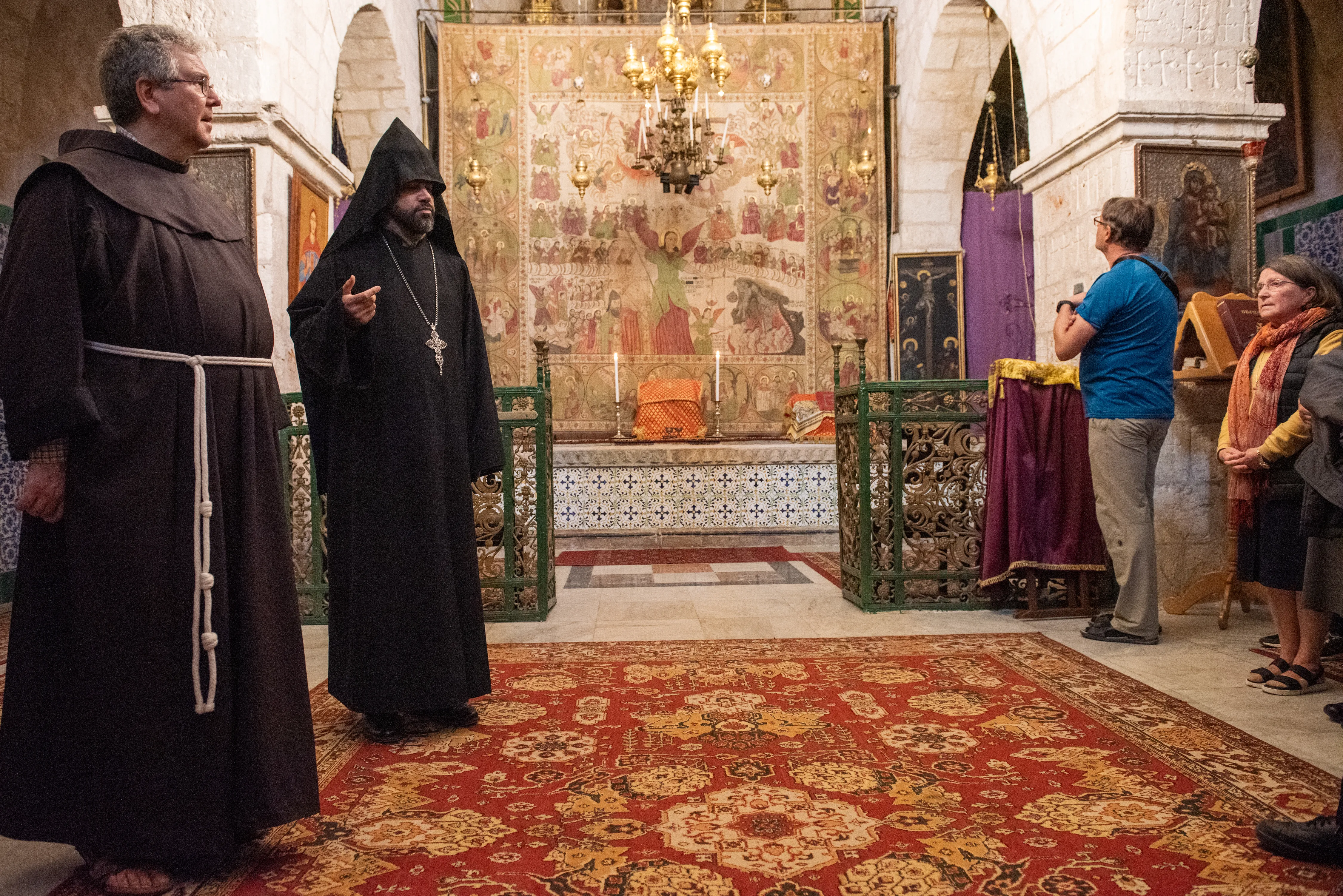
This yearly visit commemorates the hospitality the friars received in the 16th century. After being expelled from the Cenacle, the Franciscans were welcomed by the Armenians for seven years while the convent of St. Saviour was purchased, to this day the headquarters of the Custody of the Holy Land. Friars and faithful prayed together and received the blessing from the representative of the Armenian Apostolic Church.
The Syriac Orthodox Church of St. Mark is said to be built on the house of Mary, the mother of the evangelist Mark. According to Syriac tradition, this is the place where Jesus had the Last Supper. Here as well, those present prayed together and were able to listen to the Lord’s Prayer sung in Aramaic by one of the monks, who then gave a blessing.
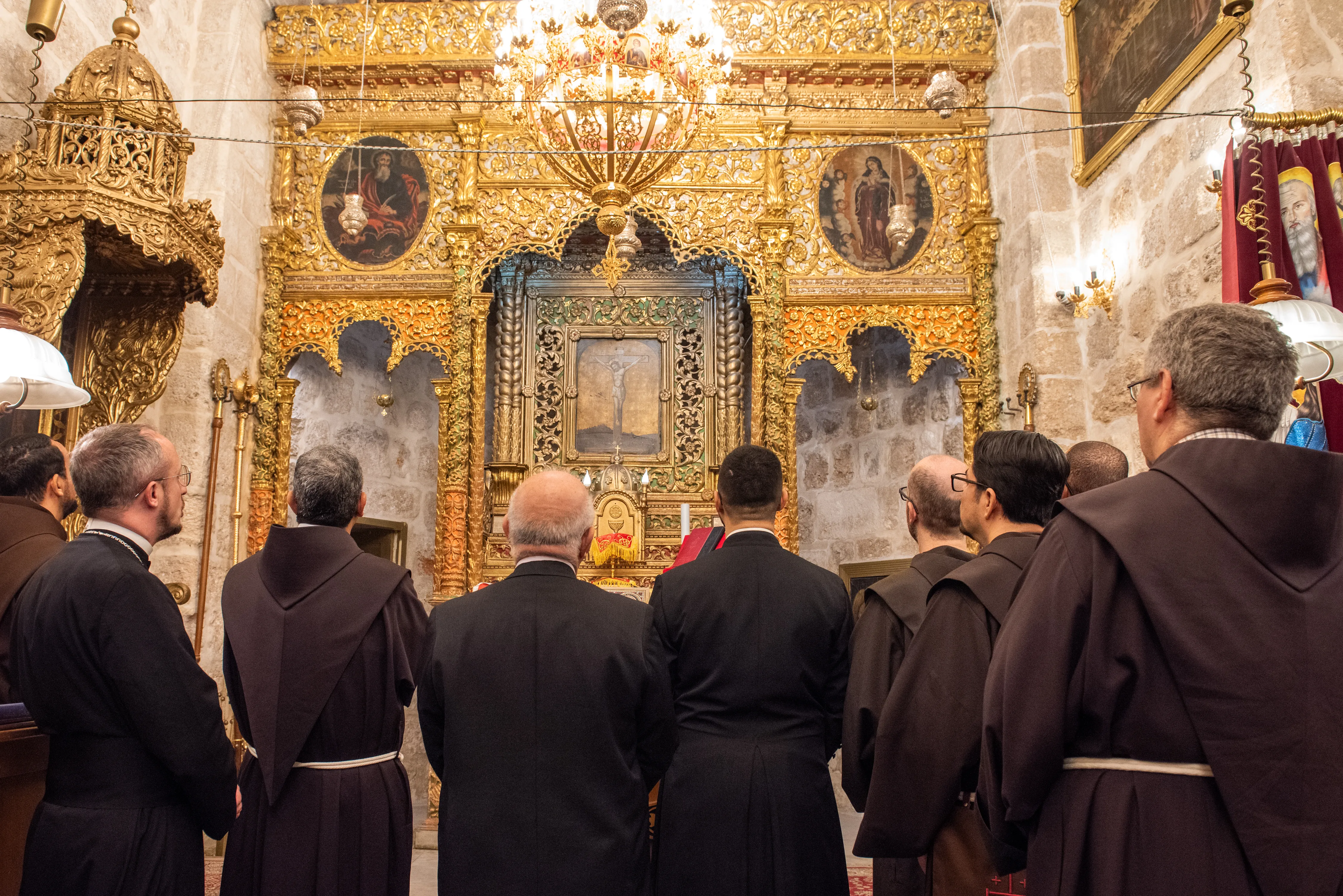

Pope Francis kisses the foot of one of the 12 women whose feet he washed at the Rebibbia Women’s Prison in Rome on Holy Thursday, March 28, 2024. / Credit: Vatican Media
CNA Staff, Mar 28, 2024 / 14:30 pm (CNA).
Pope Francis on Thursday washed … […]

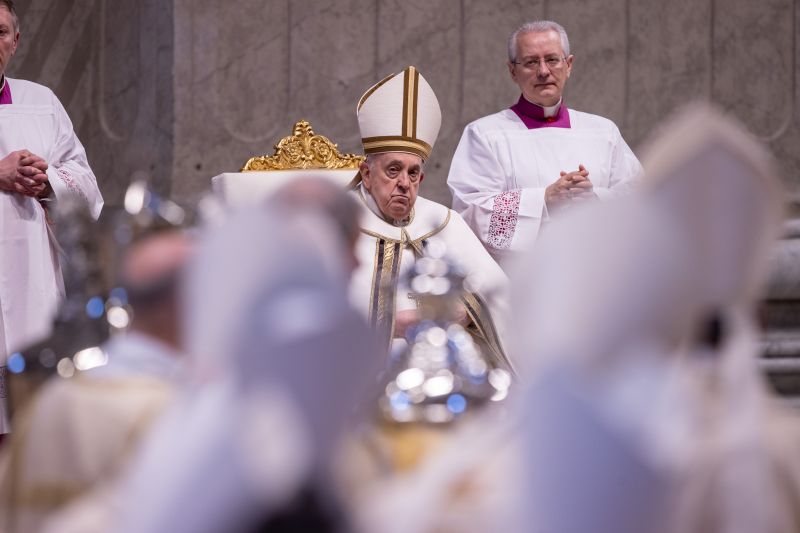 Pope Francis presides at the Vatican’s chrism Mass on Holy Thursday, March 28, 2024. / Credit: Daniel Ibanez/CNA
Pope Francis presides at the Vatican’s chrism Mass on Holy Thursday, March 28, 2024. / Credit: Daniel Ibanez/CNA
Vatican City, Mar 28, 2024 / 09:30 am (CNA).
On Holy Thursday, Pope Francis presided over a chrism Mass at which more than 1,880 priests, bishops, and cardinals renewed the promises made at their ordinations.
Pope Francis encouraged the priests to turn their gaze upon the crucified Lord and to weep over their sins in repentance, saying that tears can “purify and heal the heart.”
“Once we recognize our sin, our hearts can be opened to the working of the Holy Spirit, the source of living water that wells up within us and brings tears to our eyes,” Francis said on March 28.

“The Lord seeks, especially in those consecrated to him, men and women who weep for the sins of the Church and the world and become intercessors on behalf of all,” he added.
Forty-two cardinals, 42 bishops, and 1,800 priests living in Rome concelebrated the Mass with the pope in St. Peter’s Basilica.
Holy Thursday marks the institution of the Eucharist and institution of the sacrament of the priesthood at the Last Supper. Pope Francis will also preside over a Mass of the Lord’s Supper on Thursday evening at a women’s prison in Rome.
The 87-year-old pope arrived in St. Peter’s Basilica on Thursday morning in a wheelchair. Before giving his more than 20-minute homily, the pope took a sip of water and put on his reading glasses.
Pope Francis reflected in his homily on Peter’s tears after denying the Lord three times as recorded in the Gospel of Luke: “Peter remembered the word of the Lord … and went out and wept bitterly.”
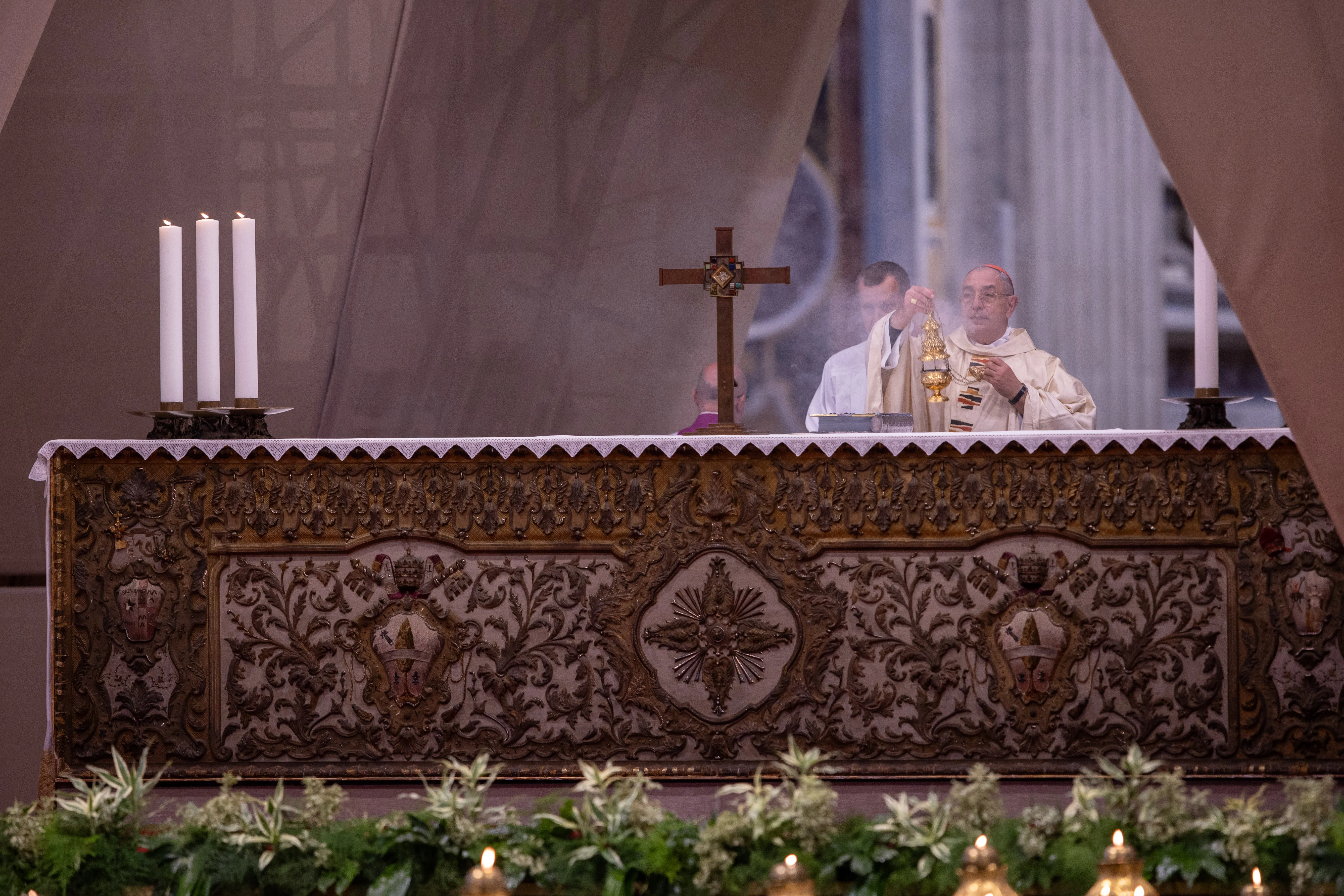
“Dear brother priests, the healing of the heart of Peter, the healing of the apostle, the healing of the pastor, came about when, grief-stricken and repentant, he allowed himself to be forgiven by Jesus. That healing took place amid tears, bitter weeping, and the sorrow that leads to renewed love,” he said.
Pope Francis said that he wanted to speak to the priests about the importance of compunction — an awareness of guilt due to sin — which the pope admitted is a “somewhat old-fashioned” term and “an aspect of the spiritual life that has been somewhat neglected, yet remains essential.”
The pope added that compunction “is not a sense of guilt that makes us discouraged or obsessed with our unworthiness, but a beneficial ‘piercing’ that purifies and heals the heart.”
“Compunction demands effort but bestows peace. It is not a source of anxiety but of healing for the soul, since it acts as a balm upon the wounds of sin, preparing us to receive the caress of the heavenly physician, who transforms the ‘broken, contrite heart,’” Pope Francis said.

The pope said that through compunction “the natural tendency to be indulgent with ourselves and inflexible with others is overturned and, by God’s grace, we become strict with ourselves and merciful toward others.”
“Weeping for ourselves … means seriously repenting for saddening God by our sins … It means looking within and repenting of our ingratitude and inconstancy, and acknowledging with sorrow our duplicity, dishonesty, and hypocrisy — clerical hypocrisy, dear brothers, that hypocrisy which we slip into so much — beware of clerical hypocrisy,” Francis said.
“How greatly we need to be set free from harshness and recrimination, selfishness and ambition, rigidity and frustration, in order to entrust ourselves completely to God and to find in him the calm that shields us from the storms raging all around us,” he added.
“Let us pray, intercede, and shed tears for others; in this way, we will allow the Lord to work his miracles. And let us not fear, for he will surely surprise us.”
During the Vatican’s chrism Mass, the pope, as the bishop of Rome, blessed the oil of the sick, the oil of catechumens, and the chrism oil, which will be used in the diocese during the coming year. Cardinal Angelo De Donatis served as the celebrant at the altar.
The oils were processed up the main altar of St. Peter’s in large silver urns as the hymns of the Sistine Chapel Choir filled the basilica.
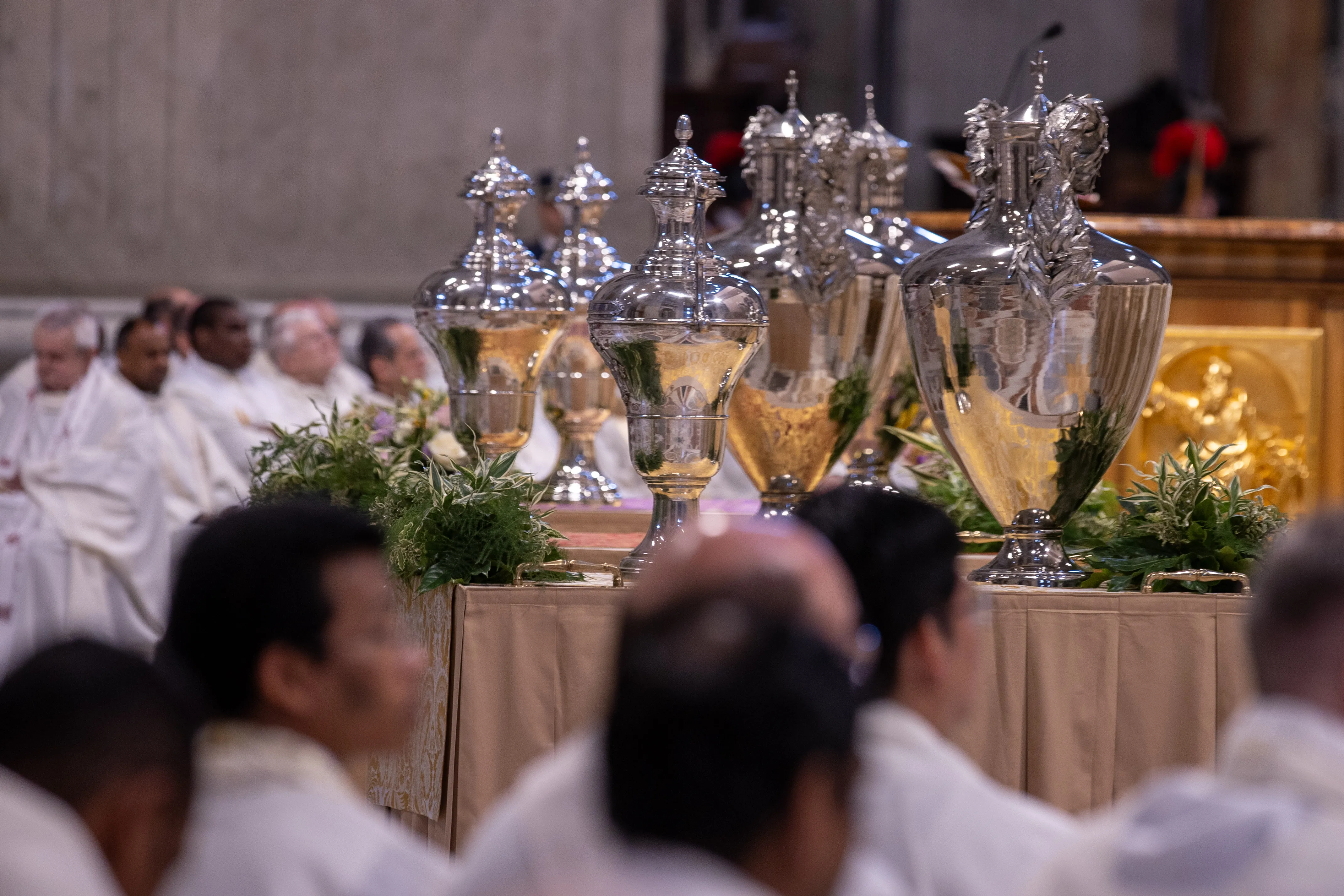
Pope Francis prayed over the oil of the sick: “O God, Father of all consolation, who through your Son have willed to heal the infirmities of the sick, listen favorably to this prayer of faith: Send down from heaven, we pray, your Holy Spirit, the Paraclete, upon the rich substance of this oil, which you were pleased to bring forth from vigorous green trees to restore our bodies, so that by your holy blessing this oil may be for anyone who is anointed with it a safeguard for body, mind, and spirit, to take away every pain, every infirmity, and every sickness.”
The blessed oil will be used for the anointing of the sick in Rome throughout the year.
Pope Francis thanked the priests gathered in St. Peter’s Basilica for all they do to bring “the miracle of God’s mercy” to the world today.
“Dear priests, thank you for your open and docile hearts; thank you for your labors and thank you for your tears; thank you because you bring the miracle of mercy … you bring God to the brothers and sisters of our time,” he said. “Dear priests, may the Lord console you, confirm you, and reward you.”
Watch the full Mass here:

null / Credit: licesio/www.shutterstock.com
CNA Staff, Mar 27, 2024 / 08:00 am (CNA).
The Visitation to Seven Churches is a Holy Thursday devotion primarily practiced in Latin America, Italy, Poland, and the Philippines — though it is also… […]

 Pope Francis at the Easter Vigil Mass in St. Peter’s Basilica on April 8, 2023. / Credit: Vatican Media
Pope Francis at the Easter Vigil Mass in St. Peter’s Basilica on April 8, 2023. / Credit: Vatican Media
Rome Newsroom, Feb 29, 2024 / 12:10 pm (CNA).
The Vatican has released Pope Francis’ schedule for Holy Week 2024, which will include five papal liturgies, Stations of the Cross at the Colosseum, and other traditions to mark the most sacred week of the year.
Easter is the highest feast in the Catholic Church, known as the “solemnity of solemnities,” celebrating Jesus’ resurrection and defeat of sin and death, and the Vatican celebrates Holy Week with pomp, reverence, tradition, and a busy schedule.
The 87-year-old pope is scheduled to preside over liturgies on each day of the Easter Triduum as well as Palm Sunday.
The Holy See Press Office published the pope’s Holy Week schedule one day after Pope Francis visited the hospital for diagnostic tests. Reuters reported that the pope had a CT scan during the hospital checkup. Last year, Pope Francis was discharged from the hospital one day before presiding over Palm Sunday Mass.
Holy Week 2024 begins on March 24 with Palm Sunday and culminates with Easter on March 31. Here is the Vatican’s full schedule:

On Sunday morning, March 24, Pope Francis is scheduled to preside over Mass for Palm Sunday, also known as Passion Sunday or the Commemoration of the Lord’s Entrance into Jerusalem.
The Mass, which will be in St. Peter’s Square at 10 a.m. local time, will kick off with a grand procession of deacons, priests, bishops, cardinals, and laypeople carrying palms.
The procession includes olive tree branches, palm fronds, and the large, weaved palms called “parmureli,” all blessed by Pope Francis.
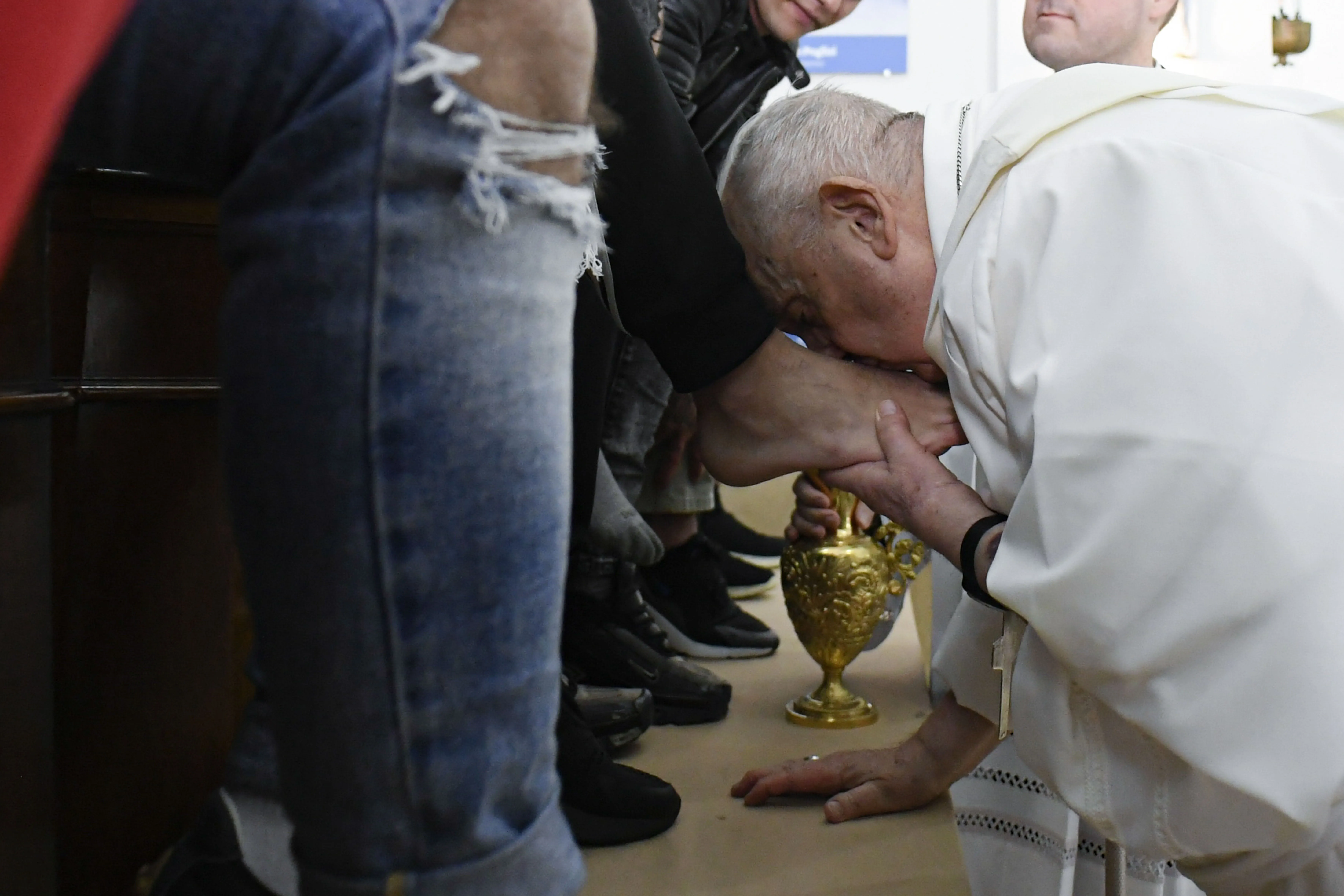
Pope Francis is set to start Holy Thursday with a chrism Mass in St. Peter’s Basilica at 9:30 a.m. in the presence of cardinals, bishops, and priests living in Rome.
During the Mass, Pope Francis, as the bishop of Rome, will bless the oil of the sick, the oil of catechumens, and the chrism oil to be used in the diocese during the coming year.
The Vatican has yet to release the details for where Pope Francis will celebrate Holy Thursday Mass 2024. Last year, the pope offered Mass at the juvenile detention center Casal del Marmo, the same detention center where he offered Holy Thursday Mass in 2013 shortly after his election.

Continuing the liturgies of the Triduum, Pope Francis is also scheduled to preside over a celebration for the Passion of the Lord on Good Friday at 5 p.m. in St. Peter’s Basilica.
During this liturgy, which is not a Mass, Cardinal Raniero Cantalamessa, the papal preacher, typically preaches instead of the pope.
In the evening, Pope Francis will lead the Stations of the Cross devotion at 9:15 p.m. in Rome’s Colosseum illuminated by candlelight.
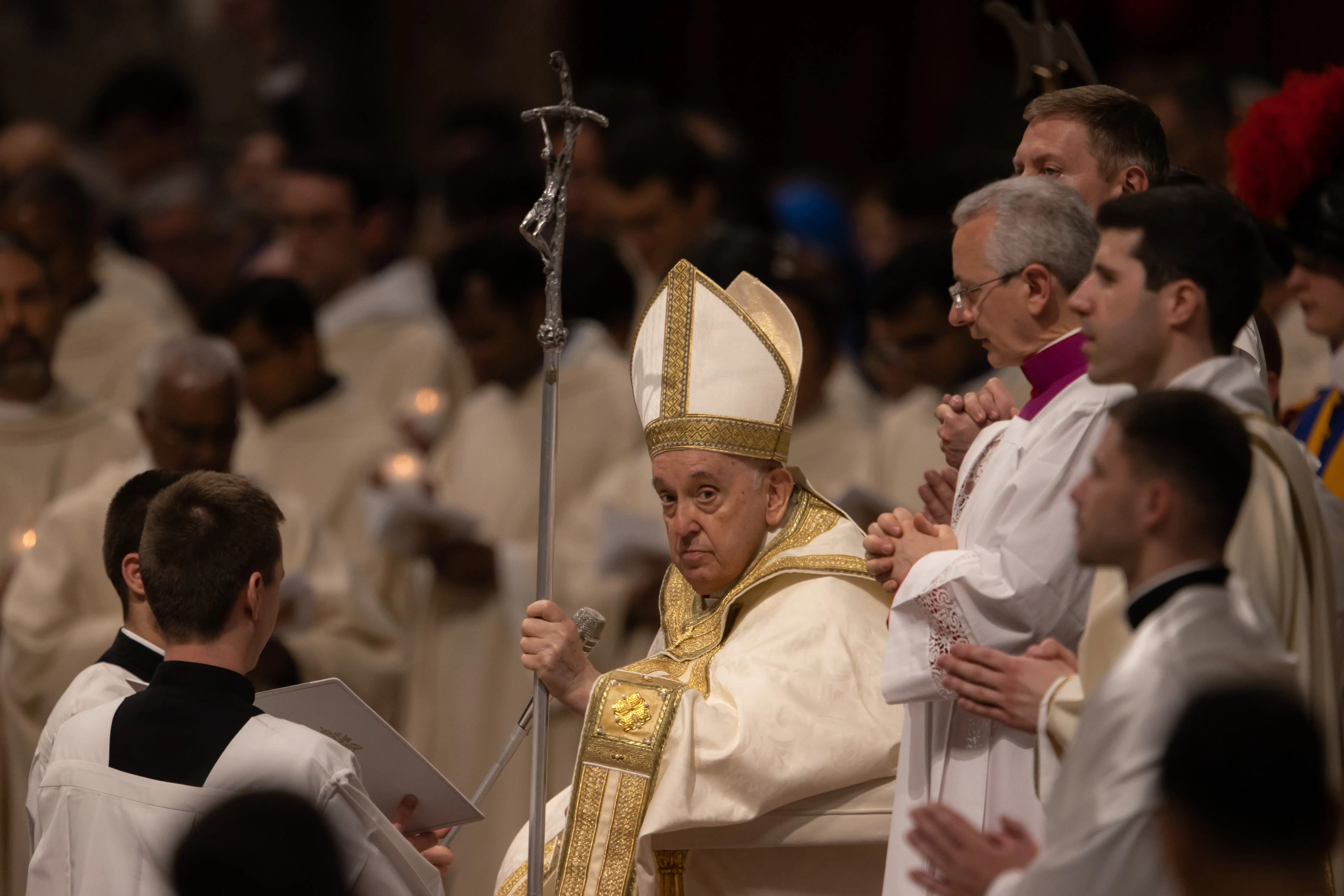
On Holy Saturday, Pope Francis is set to preside over the Easter Vigil at 7:30 p.m. in St. Peter’s Basilica.
The Easter Vigil, which takes place on Holy Saturday night, “is the greatest and most noble of all solemnities,” according to the Roman Missal.
The liturgy begins in darkness with the blessing of the new fire and the preparation of the paschal candle. At the Vatican, cardinals, bishops, and priests process through the dark basilica carrying lit candles to signify the light of Christ coming to dispel the darkness.
Pope Francis also typically baptizes new Catholics at this Mass.
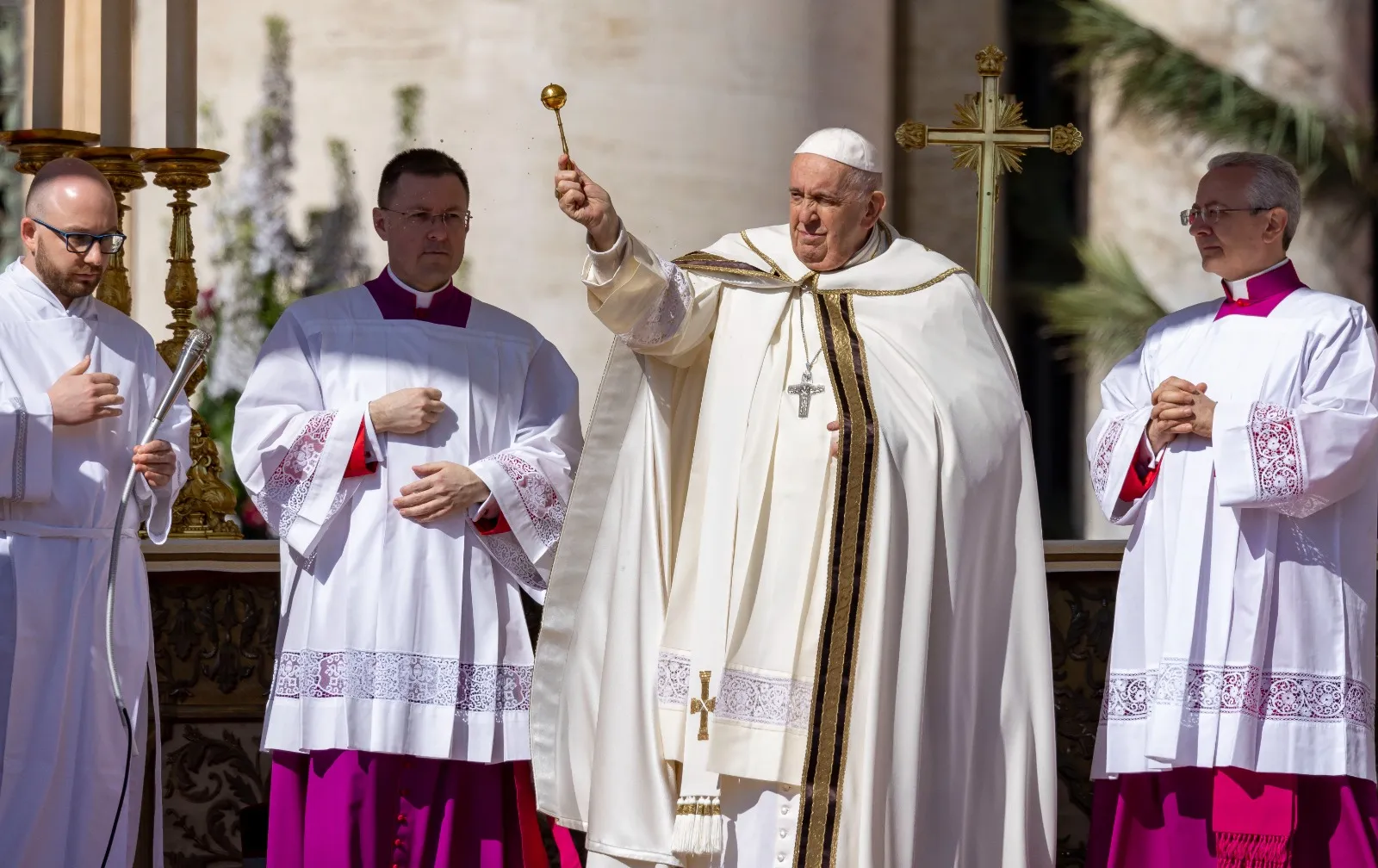
The morning of Easter Sunday, Pope Francis will preside over Mass in St. Peter’s Square at 10 a.m. on a flower-decked parvise.
After Mass, he will give the annual Easter “urbi et orbi” blessing at noon from the central balcony of St. Peter’s Basilica.
“Urbi et orbi” means “to the city [of Rome] and to the world” and is a special apostolic blessing given by the pope every year on Easter Sunday, Christmas, and other special occasions.
In 2023, local authorities estimated that there were close to 100,000 people present in St. Peter’s Square for the blessing.

Pope Francis washes the feet of 12 young men and women, inmates at Casal del Marmo juvenile detention center on Rome’s outskirts, during a Mass of the Lord’s Supper on Thursday, April 6, 2023. / Credit: Vatican Media
Rome Newsroom, Apr 6, 2023 … […]

Pope Francis presided over a Chrism Mass at which more than 1,880 priests, bishops, and cardinals renewed the promises made at their ordinations on April 6, 2023. / Daniel Ibanez/CNA
Vatican City, Apr 6, 2023 / 03:50 am (CNA).
On Holy Thursday,… […]

In many Catholic parishes on Holy Thursday, a foot-washing ritual is incorporated into Mass. Although optional, most parishes choose to do it, for it is a most powerful symbol in the present day, just as […]

Pope Francis washes inmates’ feet at Rome’s Regina Coeli Prison on Holy Thursday, March 29, 2018. / Vatican Media.
Washington D.C., Apr 3, 2023 / 12:09 pm (CNA).
Less than a week after being released from Gemelli Hospital, where he was being tr… […]
© Catholic World Report